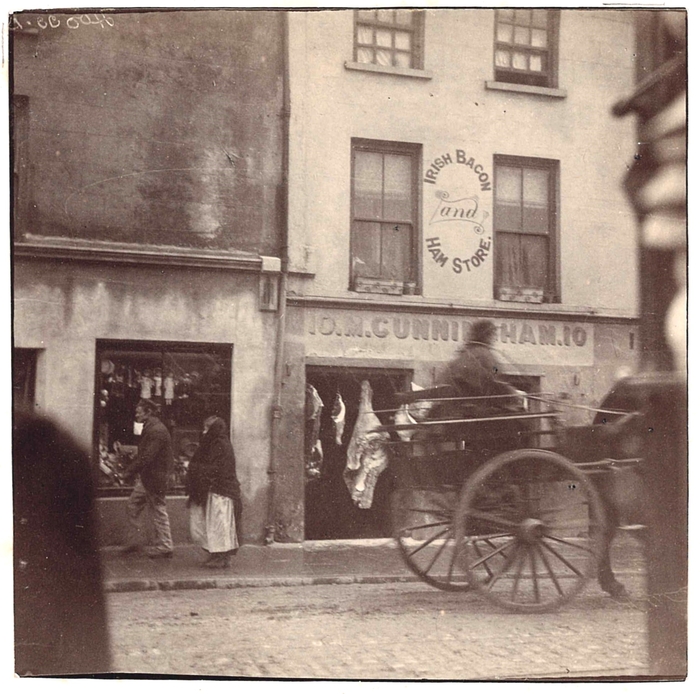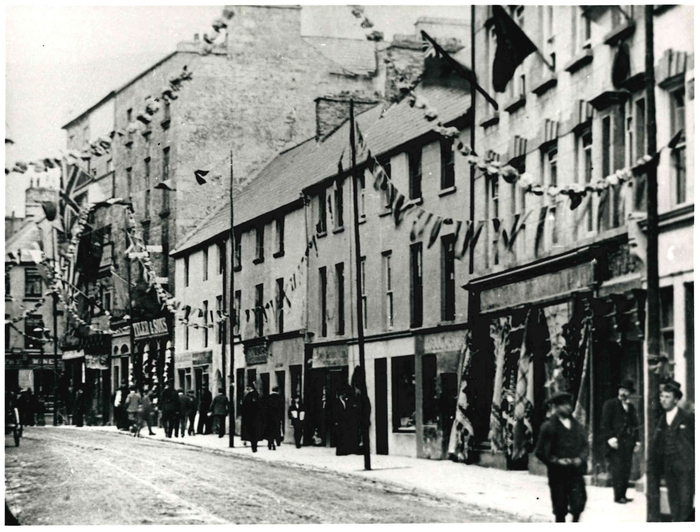This superb image of Martin Cunningham’s butcher shop at Number 10, Shop Street was taken c.1900. In the 1901 census, the occupants of this building are listed as Martin Cunningham, aged 50; his wife Delia aged 30 and their children Michael aged 12, Mary Margaret 7, James 3, Delia 2 and Martin J. who had just been born. The family lived over the shop.
Martin Cunningham ran exactly the same advertisement in local newspapers over a number of years between 1899 and 1902. A sample of it, published in 1902, is illustrated here.

As you can see, his shopfront was simple and practical with no frills except for the elegant message painted on the first floor. Unfortunately, the passing pony and trap obscures most of the facade. The tram tracks are just visible in the foreground. This image comes from the old photograph album we mentioned recently that was bought by Norman Healy at an auction in the U.K. The following legend, which I don’t understand, is written under the photograph in the album “One of Galway’s Fighting Priests”.
At around the same time as this image was taken, another Cunningham, Matthew, a possible relation of Martin’s, had a butcher shop on Abbeygate Street.

Our second photograph is from a glass plate slide, dates from 1903 and shows Shop Street decorated for the visit of Edward VII. Cunningham’s butcher shop is the dark façade just past the middle pole. Among the other businesses on the street at the time were Donnellan’s, Commins and Greaney, Brennan’s (with the shawls hanging outside ), Hardiman’s, another branch of Brennan’s, Carney’s pub and bun shop, Talbot’s Saddlery, Tyler’s shoe shop, Toner’s betting shop which was always a barber’s shop, Johnny Egan’s Pork Butchers and the River Plate Meat Company which occupied the end building.

In those days, there were a number of archways or ‘entries’ along the street, each one leading into a little courtyard at the back of the shops. These courtyards usually housed tenements or stables for horses.
There was one set into the white façade towards the left of our picture. It was known, for some reason, as ‘The Fox and Hounds’ and led into a small tenement square. An old lady named Mrs. Joyce used to sit there daily making and selling white linen caps. These frilled caps, which were tied under the chin, were much in vogue among elderly women at the time. Down at the end of the entry, there was a man named ‘Brienín’ – probably O’Brien – who made his living by making whips for the jarveys or selling thongs to be mounted on whips by the purchasers at home.
There was another entry between Carney’s and Hardiman’s, and a third beside Brennan’s which was known as ‘The Flag Entry’. Another old lady, a competitor of the above mentioned Mrs. Joyce, used to sit there and make and sell those white frilly caps too.
Our thanks to Norman Healy for the photograph of the butcher shop.

